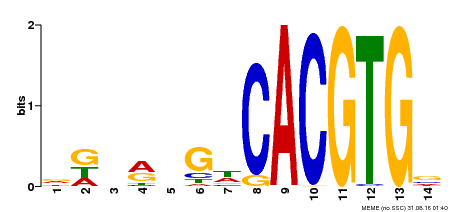 |
PlantRegMap/PlantTFDB v5.0
Plant Transcription
Factor Database
|
| Home TFext BLAST Prediction Download Help About Links PlantRegMap |
Transcription Factor Information
| Basic Information? help Back to Top | |||||||||
|---|---|---|---|---|---|---|---|---|---|
| TF ID | ORUFI03G37840.2 | ||||||||
| Organism | |||||||||
| Taxonomic ID | |||||||||
| Taxonomic Lineage |
cellular organisms; Eukaryota; Viridiplantae; Streptophyta; Streptophytina; Embryophyta; Tracheophyta; Euphyllophyta; Spermatophyta; Magnoliophyta; Mesangiospermae; Liliopsida; Petrosaviidae; commelinids; Poales; Poaceae; BOP clade; Oryzoideae; Oryzeae; Oryzinae; Oryza
|
||||||||
| Family | bHLH | ||||||||
| Protein Properties | Length: 443aa MW: 47921.6 Da PI: 6.5062 | ||||||||
| Description | bHLH family protein | ||||||||
| Gene Model |
|
||||||||
| Signature Domain? help Back to Top | |||||||
|---|---|---|---|---|---|---|---|
| No. | Domain | Score | E-value | Start | End | HMM Start | HMM End |
| 1 | HLH | 55.5 | 1e-17 | 224 | 270 | 4 | 55 |
HHHHHHHHHHHHHHHHHHHHHCTSCCC...TTS-STCHHHHHHHHHHHHHHH CS
HLH 4 ahnerErrRRdriNsafeeLrellPkaskapskKlsKaeiLekAveYIksLq 55
hn ErrRRdriN+++ L+el+P++ K +Ka+iL +A+eY+ksLq
ORUFI03G37840.2 224 VHNLSERRRRDRINEKMRALQELIPHC-----NKTDKASILDEAIEYLKSLQ 270
6*************************8.....6******************9 PP
| |||||||
| Protein Features ? help Back to Top | ||||||
|---|---|---|---|---|---|---|
| Database | Entry ID | E-value | Start | End | InterPro ID | Description |
| CDD | cd00083 | 2.59E-18 | 215 | 274 | No hit | No description |
| SuperFamily | SSF47459 | 4.45E-20 | 218 | 276 | IPR011598 | Myc-type, basic helix-loop-helix (bHLH) domain |
| PROSITE profile | PS50888 | 18.635 | 220 | 269 | IPR011598 | Myc-type, basic helix-loop-helix (bHLH) domain |
| Pfam | PF00010 | 6.4E-15 | 224 | 270 | IPR011598 | Myc-type, basic helix-loop-helix (bHLH) domain |
| Gene3D | G3DSA:4.10.280.10 | 4.6E-21 | 224 | 274 | IPR011598 | Myc-type, basic helix-loop-helix (bHLH) domain |
| SMART | SM00353 | 6.2E-18 | 226 | 275 | IPR011598 | Myc-type, basic helix-loop-helix (bHLH) domain |
| Gene Ontology ? help Back to Top | ||||||
|---|---|---|---|---|---|---|
| GO Term | GO Category | GO Description | ||||
| GO:0006355 | Biological Process | regulation of transcription, DNA-templated | ||||
| GO:0006783 | Biological Process | heme biosynthetic process | ||||
| GO:0009740 | Biological Process | gibberellic acid mediated signaling pathway | ||||
| GO:0009959 | Biological Process | negative gravitropism | ||||
| GO:0010100 | Biological Process | negative regulation of photomorphogenesis | ||||
| GO:0010161 | Biological Process | red light signaling pathway | ||||
| GO:0010187 | Biological Process | negative regulation of seed germination | ||||
| GO:0015995 | Biological Process | chlorophyll biosynthetic process | ||||
| GO:0005634 | Cellular Component | nucleus | ||||
| GO:0003677 | Molecular Function | DNA binding | ||||
| GO:0003700 | Molecular Function | transcription factor activity, sequence-specific DNA binding | ||||
| GO:0010313 | Molecular Function | phytochrome binding | ||||
| GO:0042802 | Molecular Function | identical protein binding | ||||
| GO:0046983 | Molecular Function | protein dimerization activity | ||||
| Sequence ? help Back to Top |
|---|
| Protein Sequence Length: 443 aa Download sequence Send to blast |
MAICSTDNEL VELLWHNGGV VAQPQAAQAR VVSSSGRGQS ASVLTGDDTE TAAWFPDTLD 60 DALEKDLYTQ LWRSVTGDAF PAAAAAGPSS HHAPPPDLPP PAARPPMRSG IGSSWTGDIC 120 SAFCGSNHIP ETAAQRCRDA GAALPPERPR RSSTHDGAGT SSSGGSGSNF GASGLPSESA 180 SAHKRKGRED SDSRSEDAEC EATEETKSSS RRYGSKRRTR AAEVHNLSER RRRDRINEKM 240 RALQELIPHC NKTDKASILD EAIEYLKSLQ MQVQIEIVES VPQIMWMTTG MAPMMFPGAH 300 QFMPPMAVGM NSACMPAAQG LSHMSRLPYM NHSMPNHIPL NSSPAMNPMN VANQMQNIQL 360 REASNPFLHP DGWQTVPPQV SGPYASGPQV AQQNQIPKAS ASTDKEFNVG FAQRVVFLEI 420 AENIDMMNRL HPYCCYVSQS VSV |
| Nucleic Localization Signal ? help Back to Top | |||
|---|---|---|---|
| No. | Start | End | Sequence |
| 1 | 215 | 232 | KRRTRAAEVHNLSERRRR |
| 2 | 228 | 233 | ERRRRD |
| Functional Description ? help Back to Top | ||||||
|---|---|---|---|---|---|---|
| Source | Description | |||||
| UniProt | Transcription factor that may act as negative regulator of phyB-dependent light signal transduction (PubMed:17485859). Transcription activator that acts as positive regulator of internode elongation. May function via regulation of cell wall-related genes. May play a role in a drought-associated growth-restriction mechanism in response to drought stress (PubMed:22984180). {ECO:0000269|PubMed:17485859, ECO:0000269|PubMed:22984180}. | |||||
| Binding Motif ? help Back to Top | |||
|---|---|---|---|
| Motif ID | Method | Source | Motif file |
| MP00074 | ChIP-chip | Transfer from AT2G20180 | Download |

| |||
| Regulation -- Description ? help Back to Top | ||||||
|---|---|---|---|---|---|---|
| Source | Description | |||||
| UniProt | INDUCTION: Induced by light in dark-grown etiolated seedlings (PubMed:17485859). Circadian oscillation under 12 h light/12 h dark cycle conditions, with peaks in the middle of the light period (PubMed:17485859, PubMed:22984180). Down-regulated by cold and drought stresses (PubMed:22984180). {ECO:0000269|PubMed:17485859, ECO:0000269|PubMed:22984180}. | |||||
| Regulation -- PlantRegMap ? help Back to Top | ||||||
|---|---|---|---|---|---|---|
| Source | Upstream Regulator | Target Gene | ||||
| PlantRegMap | Retrieve | Retrieve | ||||
| Annotation -- Nucleotide ? help Back to Top | ||||||
|---|---|---|---|---|---|---|
| Source | Hit ID | E-value | Description | |||
| GenBank | AK105637 | 0.0 | AK105637.1 Oryza sativa Japonica Group cDNA clone:001-200-E02, full insert sequence. | |||
| Annotation -- Protein ? help Back to Top | |||||||
|---|---|---|---|---|---|---|---|
| Source | Hit ID | E-value | Description | ||||
| Refseq | XP_015633325.1 | 0.0 | transcription factor PHYTOCHROME INTERACTING FACTOR-LIKE 13-like isoform X5 | ||||
| Swissprot | Q10CH5 | 0.0 | PIL13_ORYSJ; Transcription factor PHYTOCHROME INTERACTING FACTOR-LIKE 13 | ||||
| TrEMBL | A0A0E0P243 | 0.0 | A0A0E0P243_ORYRU; Uncharacterized protein | ||||
| STRING | OBART03G36360.1 | 0.0 | (Oryza barthii) | ||||
| Best hit in Arabidopsis thaliana ? help Back to Top | ||||||
|---|---|---|---|---|---|---|
| Hit ID | E-value | Description | ||||
| AT3G59060.1 | 2e-29 | phytochrome interacting factor 3-like 6 | ||||
| Publications ? help Back to Top | |||
|---|---|---|---|
|
|||



